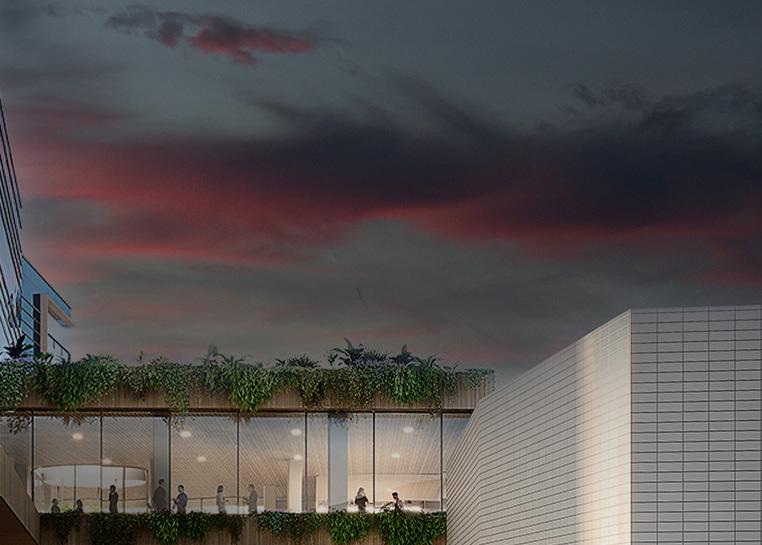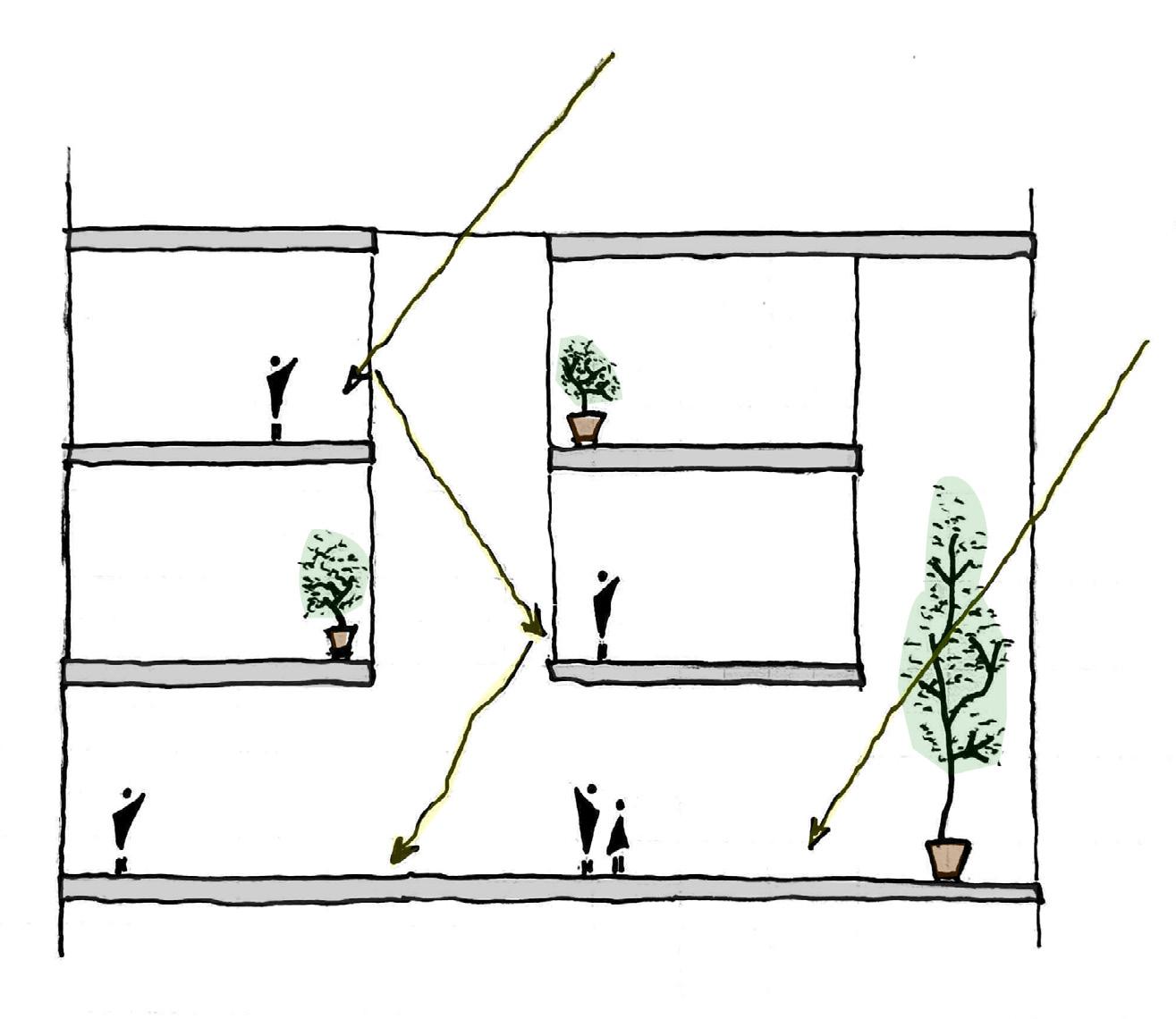Think… Revive and revitalise commercial buildings





Climate change, technological disruption, hybrid work, a housing affordability crisis, shifting demographics and evolving values... At the intersection of all these megatrends sits the commercial office.
How we use office space is changing –and this is influencing the value of assets around Australia. In the case of B and C grade building stock, vacancy rates are increasing as tenants take flight to higher quality spaces packed with wellness features and energy efficient technology, and with the verified green ratings that support their net zero ambitions.
ADP is working with building owners and design teams on a range of building transformations to assess, electrify and enhance building stock, ultimately resulting in highly tenanted buildings with higher rental yields.
We have some insights to share.
Building upgrades can take several pathways, depending on the bones of the building and the budget of the owner.
The climate clock is ticking! So, what is stalling projects and progress? We don’t believe the issue is an industry skills gap. There is a long list of successful projects, and teams of skilled consultants, architects and contractors ready to roll up their sleeves and deliver work.
This paper examines the trends and drivers influencing each of these types of upgrades, and shares insights into the challenges of electrification, NABERS and adaptive reuse. We aim to contribute to the growing body of knowledge in the industry to encourage the uptake of these transformational projects.

Current asset (high energy usage, runs on gas, poor occupancy and low rent)
Options for an upgrade

NABERS uplift (energy efficiency improvements)
Building owners are prevented from seeing the full potential of their ageing assets due to the combination of a multidisciplinary knowledge gap and a robust business case. This can change. The answer to acceleration, therefore, is to share solid business cases, ideas on architectural enhancements that can be implemented now, and the quantifiable benefits when smart engineering comes together with a commitment to ESG.

Electrification (removal of fossil fuel systems)

Extension or modification (large change in structure and architecture)

Adaptive reuse (change of use –e.g. residential)
Everyone says the greenest building is the one that already exists. At ADP, we have a caveat: As long as the building is electrified and supplied with 100% renewable energy.
Building emissions can be split into upfront and operational carbon.
The upfront carbon – the emissions generated during the manufacture and transport of materials, and during the construction process – can account for as much as 80% of a building’s lifetime carbon footprint. Depending on the materials and construction method, between ~600 and 1,000 kgC02e/sqm can be generated before an occupant even walks through the door for the first time.
The operational emissions depend on building efficiency (passive and active), tenant behaviour and the energy source.
Electrification, which is the process of removing gas and fossil fuel equipment from a building and replacing it with electrically-driven equipment, is required for our building stock to meet net zero targets.
As the electricity grid transitions from coal and gas power stations to solar and wind power, these buildings will approach net zero in operation by the middle of the century. Some buildings are net zero in operation now – and these are the buildings that tenants with progressive net zero trajectories are looking for.
Total kgCO2e/sqm(GBA) (embodied and operational*) for different building scenarios
Existing 3 star NABERS asset on gas
New 5.5 star NABERS building
Existing 5 star NABERS and electrified
Existing 5 star NABERS, electrified, renewables * Operational carbon is based on predicted Victorian Grid decarbonisation
What’s required for a successful retrofit?
Successful retrofits require a range of ingredients:
• bold asset managers and owners
• progressive and creative design teams
• a sound business case
• solutions that deliver the highest and best use.
Here are the main considerations that asset owners must think about:
• Is this the right building to transform and is it the right time?
• What is the market demand for green buildings?
• Is there a robust business case for the transformation?
• Has the building been optimised for a high NABERS rating?
• How will I electrify the asset to align with a net zero pathway?
• What’s required to electrify a particular asset?
• What other compliance and secondary issues will need to be addressed during a transformation?
The operational emissions depend on building efficiency, tenant behaviour and the energy source.
Choosing the right building can make or break a revitalisation.
Knowledgeable facility management and comprehensive existing building information
Adequate roof plant space for heat pumps, solar arrays and roof top amenity
Floor plate suitable for final purpose; deep floor plates may not offer sufficient natural light for residential conversions
Feasibility studies are critical for determining the business case. Focussed design teams can help clients to identify poor performing assets with easy wins and uplifts.
Poorly selected buildings can quickly result in non-viable schemes.
Well selected buildings are low risk and deliver successful conversions.
On-floor mechanical systems that can work with lower hot water supply temperatures that come from heat pumps
Robust structure with seismic integrity and compliant fire separation between floors; structural form may also have architectural value if exposed
Nearby ground level amenity that complements the building and occupant needs
Premium location in CBD with nearby public transport and bike routes
Heritage or architectural character worth preserving and displaying
Equitable and DDA compliant access (e.g. not requiring additional ramps or other modifications)

Central core with adequate riser space for PCA requirements and dual protected stairs for escape with compliant travel distances
Structure and form that allows possible extensions
Floor heights above 3.7m, to achieve final ceiling heights above 2.7m
Adequate wet fire systems and building works that don't trigger a full NCC upgrade
No asbestos or hazardous materials (1960s-1980s construction)
Good thermal envelope that requires minimal enhancement. (façade upgrades can be expensive)
Possible extensions to the building with vacant lots; space for end-of-trip
Crane locations and site attributes that allow plant replacement and works to occur
Adequate incoming power supply; buildings with modern switchboards and switchrooms allow cheaper electrification conversions
Chadstone Place is a great example of commercial office revitalisation. It now achieves a 5.5 star NABERS Energy Base Building commitment agreement and is on track to achieve Australia's first ILFI Zero Carbon Certification


Why is demand for green buildings growing? There are a range of reasons but here are five of the biggest.
1. Net zero targets: Australia has a national net zero target by 2050 and some state and local governments have set targets that are even more ambitious. Meanwhile London has a net zero target by 2030. Overlay these with the targets set by progressive companies – some planning to reach net zero operations by 2025 and many by 2030 – and it’s easy to see where the market is moving.
2. Tenant demand: 70% of occupiers are willing to pay a premium to lease a sustainability-certified building, based on research by JLL.
3. Investor appetite: 72% of investors believe that green certifications drive higher occupancy, rents, tenant retention and overall higher asset value, JLL research has found.
4. Employee attraction and retention: Healthy features, wellbeing facilities and green space are valuable commodities when attracting and retaining talent, and a raft of research has confirmed green buildings boost productivity, performance, health and wellbeing.
5. Asset values: Green offices outperform their non-green peers. Because they achieve higher occupancy rates and longer weighted average lease expiries, Real Investment Analytics has found a 13.51% difference in total average returns between green and non-green offices.
A solid business case is the first step to get any retrofit project off the ground.
Key components of a business case should include:
• Current and final rental yield and occupancy rate
• Value of the existing building
• Cost of the architectural enhancements and increased building amenity
• Cost of the electrification and efficiency upgrades
• Time to market.
Architectural and amenity improvement costs
When major works are undertaken to improve a building's efficiency, they are often aligned with architectural and amenity improvements to enhance its overall value. These obviously form part of the business case and need to be considered in any decision, both from a cost and impact perspective.
Working on these improvements concurrently can minimise tenant disruption and duration of works.
Approximate costs to NABERS uplift and electrify
The cost of uplifting buildings varies significantly from site to site, as every building is unique. However, most buildings are capable of achieving at least a NABERS 4.5 star rating without major façade or significant upgrade works. Ratings of 5.5 stars are achievable when buildings possess the right attributes or have advantageous layouts.
Building improvements carried out prior to electrification can often considerably reduce the need to upgrade or replace the entire building infrastructure. For example, metering, lighting and façade modifications should take place before addressing HVAC systems and final infrastructure requirements, as these lessen the energy load on the building and reduce the need for oversized infrastructure and HVAC plant.
Uplift opportunity Requirements
Taking a poorly metered and operated building from 3 to 4 stars
Taking a building from 4 to 5 stars (or 4.5 stars if building has poor thermal envelope)
Taking a building from 5 to 5.5 stars
Reviewing leases, run times, meters and achieving easy wins (e.g. LED lighting and switching off inefficient or ineffective systems).
Replacement or upgrade of some central systems and controls. Detailed analysis of the building is required and works usually need to be phased with some tenant disruption. Some easy wins with building fabric could be undertaken.
Often requires façade upgrades and system type changes. Some buildings with poor façades will require extensive work. Some buildings don’t have adequate riser or plant space.
$5-25/sqm
$20-50/sqm
$50-100+/sqm
Electrification (easy)
Removing gas boilers and replacing them with heat pumps and replacing all associated equipment. Most work occurs in plantrooms.
Electrification (medium) Electrification requires some on-floor works, main switchboard and mains power upgrades.
Electrification (hard) Works require infrastructure upgrades, switchboard and mains upgrades. Significant plantroom and on-floor works.
$70-120/sqm
$150-200/sqm
$250+/sqm
The National Australian Built Environment Rating System (NABERS) assesses the operational performance of existing buildings.
NABERS is an independent verification that ranks buildings with a 0-6 star rating, based on their energy usage per square metre. There are also NABERS ratings for waste, water and indoor environment.
Under the Commercial Building Disclosure (CBD) Program, the NABERS Base Building Energy rating of buildings of more than 1,000sqm by net lettable area must be disclosed at the time of sale or lease. This mandated requirement makes NABERS the most critical rating tool for building performance used in Australia, and its basis on real data means that it's now being widely adopted in the UK market.
Most buildings have a 4.5 star NABERS Energy rating within them without undertaking major façade works… We just need to search for the savings!
NABERS is based on utility bills and is independently assessed, so there’s no way to cheat the system. But you can set up your building to work with the NABERS protocols to get the best possible result.
Top tips for getting a higher NABERS rating:
1. Set your metering and switchboards up correctly with the right equipment on the right board. This is a common issue in older buildings (see opposite for the general setup). Owners may be paying for their tenants electricity and not realising it!
2. Work with your NABERS assessor to establish appropriate plant run-time, leasing hours, occupancy and assessed area.
3. Implement the easy efficiency wins –LED lighting, plant run times, CO2 and CO sensors, VSDs on fans and pumps.
4. Upgrade your façade and intensely interrogate your BMS. Around two thirds of a base building rating can come from air conditioning load.
5. Electrify, as from 2025 NABERS will reward your building with a higher rating for eliminating gas.
Many buildings are not metered correctly for base building NABERS ratings. This results in low NABERS scores.
services
serving
switchboards that supply tenant lighting and power and supplementary units each with their own meter
Switchroom to have dual access and clearance requirements Unmetered section of board supplying tenant switchboards

Landlord switchboards that supply common lighting and power and central services and onfloor base building HVAC
Metered landlord section of board complete with meters. Meters connected to BMS for tracking performance and tuning.
incoming supply from substation
For Australia and the UK to achieve net zero we need to electrify.
Electrification components Items to consider
Boilers to heat pumps


Domestic water boilers to heat pumps
Electrification is the process of removing fossil fuel burning equipment from buildings and replacing it with electric alternatives. When combined with a renewable energy supply, electrification is a critical step in achieving net zero commitments.
Importantly, the technology for electrifying buildings is readily available and commercial office owners across the economy have their minds on the challenge.
But building owners are also worried about the capital expenditure. And when they think in terms of simplistic paybacks, they are right. Electrification often doesn’t pay for itself with the energy efficiency gains.


Electric vehicle chargers



Photovoltaic arrays

Battery storage and clean standby power

Electric kitchen appliances

• Potential increase in power supply
• Located on roof with large spatial footprint
• Lower water supply temperatures
• Cranage for large plant
• Increased weight on structure
• Watch out for high GWP refrigerant
• Potential increase in power supply
• Preference low GWP refrigerant (e.g. CO2)
• Can be located on roof or in carpark
• Increased spatial requirement and additional storage vessels compared to boilers
• Increased power supply, but can be fitted with load management controls
• Increased fire protection may be required (for more details see ADP’s 'Think Electric Vehicles' white paper)
• Maximise solar panels on roofs where possible as commercial buildings typically use most of the generated energy
• Can often pay for themselves in under four years, so have a good business case
• Consider cost and benefit, as batteries are usually only viable in few scenarios
• Biofuel generators are an option
• These systems can help with grid stability and reduction of maximum demand
• Potential increase in power supply
• Vast range of electric kitchen apparatus now available
• Reduced fumes and heat within kitchen – which reduces ventilation requirements
Electrification will, with time, become synonymous with high-quality, high amenity office space. In the future, building owners will be required to account for the electrification cost in the value of their assets. When the transition risk is factored in, suddenly the business case starts to stack up.
Types of renewable energy supplies:
• Onsite power generation – via solar panels (typically insufficient to supply the site)
• Green Power – via an electricity retailer
• Power Purchase Agreement (PPA) –direct investment with an offsite wind or solar farm.
Lower the peak load and lower the infrastructure cost
Electrical infrastructure upgrades are needed when the peak building electrical demand exceeds the incoming supply capacity. Infrastructure upgrades are expensive, so keeping the peak load down via demand management is critical. Some projects will still require additional substations and new main switchboards.
Ways to minimise the peak load while electrifying your building include:
• Performing efficiency enhancements (LEDs, VSDs, façade improvements)
• Load management systems on EV chargers
• Building controls that respond and turn down based on grid and building demand
• Turning off non-critical equipment (e.g. refrigeration) for small peak periods
• Implementation of energy storage technologies.
A quick review of existing switchboards and an electrical single line diagram undertaken by a skilled electrical engineer can usually find out if an infrastructure upgrade can be avoided.
The Green Building Council of Australia’s practical guide to electrification sparked a new industry-wide conversation about potential pathways for existing buildings, but there are technical challenges that must be examined on a project-by-project basis by experienced building services engineers. One of the biggest is overcoming the heat pump challenge.
High efficiency heat pumps are a great all-electric alternative to gas boilers, as they create multiple units of heat for every unit of electricity supplied into them.
However, it’s not as simple as removing the gas boiler and inserting a heat pump. Heat pumps typically produce water at lower temperatures than boilers and this has flow-on effects.
More water must be pumped around to achieve the same heating output and different elements of the water circuit need to be adapted or altered for the system to work. This can add large costs to a project.
Some conversions are easier than others.
Certain heating systems naturally work well with low grade heat. These include central condenser systems with heat injection, pool plant and underfloor heating.
These system types can usually be changed over without major system redesign, however skilled engineers are needed to determine the downstream effects.
Also look out for waste heat opportunities in and around your commercial building e.g. Data centres or industrial.

systems downstream
Pumps – Pumps are usually changed over as part of a boiler replacement as they typically pump over twice the flow rate. The higher flow also leads to higher pressure drops in the system meaning higher pumping energy is also required.
Ancillary heating plant – New controls and smaller expansion vessels are required. Water treatment must also be reviewed.
Heat exchangers – Additional plates can be added to achieve the same heat transfer capacity, however new correctly sized heat exchangers will have a lower pressure drop, which will save energy.
Piping – As water flow is increased by over two times, piping can be potentially kept depending on how it was originally sized. If sized originally with Pa/m above >1000 replacement of system piping is recommended.
Main air-handling units – AHUs have heating water coils in them which can usually be easily upgraded with new coil selections. The AHU itself can usually remain as is, subject to an engineering review.
On-floor fan coil units – Like air handling units, FCUs can potentially have their coils replaced, but this isn’t always possible leading to full replacement of on-floor systems which can be expensive. This also requires high levels of tenant disruption.
VAV boxes – Coils in VAV boxes can be replaced, but where this isn’t possible or difficult installation of heating water duct heaters should be considered.
Underfloor heating – Underfloor heating works on low water temperatures, and therefore piping within the floor can be reused without change. Valving assemblies will still require modification.
Pool plant – Pool heating systems can usually operate easily with lower grade heat subject to an engineering review.
High efficiency heat pumps are a great all-electric alternative to gas boilers, as they create multiple units of heat for every unit of electricity supplied into them.

Heat pumps are heavier than boilers, and some heat pump plant can easily add an extra 20 tonnes to the roof a building.
As such, a structural review is required to determine the viability of any boiler replacement.
The good news? Most semi-modern commercial buildings have strong cores, columns and beams. With careful placement and, perhaps, the addition of a structural decking plant, units can usually be accommodated.
New works performed on any building need to be completed in line with the current version of the National Construction Code. However, where building works are extensive, a building surveyor may require the whole building to come up to Code.
This can be prohibitively expensive, so building owners should engage a building surveyor early if works may trigger a full upgrade.
Similarly, changes of use – such as adapting an office into apartments –can trigger NCC upgrade requirements and renewed planning submissions.
Heritage specialists should also be engaged early to define heritage implications and significance. Where heritage restrictions cause an NCC non-compliance, a building surveyor will need to assess acceptability.
Heritage requirements vary from state to state. Where one state may have an advisory note, another one may have an extensive guide. Getting your head around all these conflicting requirements takes skill and time. Heritage buildings sometimes require alternative approaches to new buildings and should always be assessed by a skilled project team on a case-by-case basis.
Daylight is critical to tenant wellbeing and the feel of a space.
Daylight
Existing buildings with deep floor plates have low natural light penetration. This can be exceptionally challenging for commercial-to-residential conversions.
Architectural features such as cut back floors and light wells can improve the daylight to adequate levels.
Daylight autonomy calculations can be performed to predict how a space will perform.

Façade enhancements
Typically two thirds of a building’s base building energy usage comes from air-conditioning, and the façade is the major source of heat loss and heat gain.
Façade modifications can be expensive, but they do yield large performance improvements and large increases in the perception of the building.
Poor performing façades (single glazing, thermal bridging and low air tightness)
are unlikely to achieve 5.0 star ratings without enhancement.
Wall
Existing wall assembly composed of precast concrete panel cladding, double brickwall and wet plaster lining.
Glazing
Single glazed window with non-thermally broken frame.
Wall
Install R2.0 insulation on inside wall. Line with plasterboard.
Glazing
Install double glazing in front of existing.
Wall
Glazing
Remove existing and install thermally broken glazed window frame.
Review thermal bridging and achieve air tightness <5m�/m�@50Pa.


Install R2.0 insulation on the exterior face of the building, including water, vapour and air control layer. Allow for 30mm ventilated cavity and provide external cladding.

Analysing existing buildings and upgrading them to modern standards reveals insights into how we should view and design new buildings.
New buildings with generous floor-tofloor heights, that are designed with future flexibility in mind, and that are built with long-lasting materials are more likely to have multiple lives.
Mechanical systems last up to 25 years. Structures should stand for at least 60 years. That takes us to at least 2080.
No building designed today should be just fit for its current purpose, so how do we make our solutions flexible for the full lifespan of the building?

Brand
Anchor tenant leaves

Major tenants leave

Multi-floor tenants leave


Possible refurbishment and new anchor tenant?
Think about electrification… and think about it now.
Decision to start
Site investigation and concept report
Client education and approval to proceed
For many building owners, the upgrade may only start as major plant and equipment nears the end of its expected life – or when a major vacancy prompts a change in positioning.
But upgrading a building to meet net zero can take well over two years. Allow at least six months to design and tender a job.
Work with facilities management for non-contract efficiency upgrades
Detailed design and tender documents Tender period, interviews and contract
Air-source heat pump lead time (roughly 20 weeks)
The lead time for some heat pumps can be beyond six months. Then there’s at least a 12-month operational period before a building can achieve its NABERS rating.
And major infrastructure upgrades can take two years!
These are just four examples of why building owners should start the electrification discussion today.
Work on site (best case) supply, install, commission
Make upgrade works in contract where possible Month 14
1 year of operation to achieve NABERS rating
Month 26
NABERS rating achieved. Climate Active certification possible.
Think is a thought leadership series developed by ADP Consulting to ask and answer some of the big questions confronting the property and construction industry.
ADP Consulting’s vision is to inspire a better world through influence and design.
We are a multi-services engineering and sustainability consultancy with 270-plus people across Melbourne, Sydney, Brisbane, Gold Coast, Adelaide and London offices.
We provide building services engineering, structures, sustainability, fire engineering, ICT, acoustics, audio visual, security, vertical transportation, and specialist lighting design to the property and construction industry.
Our experts
For more information, please contact:

Author: Alex Sear
Associate Director
E: a.sear@adpconsulting.com.au
M: +61 450 074 226

Rebecca Patterson
Technical Director
E: r.patterson@adpconsulting.com.au
M: +61 400 487 729

Bruce Skipp
Associate Director
E: b.skipp@adpconsulting.com.au
M: +61 411 863 640
London Chancery House
53-64 Chancery Lane
London WC2A 1QS
Brisbane City QLD 4000
adpconsulting.com
@adp-consulting-pty-ltd
@adpconsultingptyltd
Adelaide SA 5000 Gold Coast Kurrungul 12-14 Marine Parade Southport QLD 4215